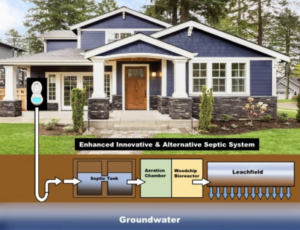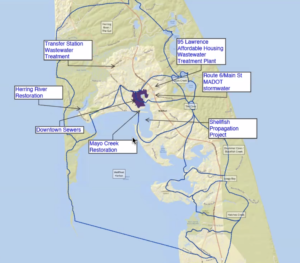WELLFLEET — The board of health got mixed reactions when it brought an amended version of its new septic system regulations to the select board on Dec. 10. The resulting discussion spurred the board to make one more amendment to the rules: an exception for properties in an approved or proposed sewer district.
The regulations, first put forward in August, are part of the town’s targeted watershed management plan — a requirement because nitrogen pollution in the harbor led to the town’s designation as a “natural resource nitrogen sensitive area” in 2023. The rules are designed to bring down the nitrogen levels in the harbor.
There are 30 such areas on Cape Cod, but Wellfleet Harbor is the only one on the Outer Cape.
The proposed regulations require that new septic systems use “best available nitrogen reducing technology” (BANRT), which emits less nitrogen than statewide-standard Title 5 septic systems. The rules outline four triggers that would compel homeowners to upgrade their systems: new construction, sale of a property, a failed septic system, or use of a cesspool.
The amendments have to do with these triggers.
Real estate transfers are still one of the events that would give rise to a required update. But in the amended version of the rules, transfers of ownership not involving a sale, such as through inheritance or establishment of a trust, would not prompt the requirement. Nor would changes in tenants.
“You put those regulations out there, you listened, and then you changed course,” select board member Barbara Carboni told the health board at the Dec. 10 meeting. “I appreciate that.”
Two days following the discussion, the board of health made a further amendment, adding that the sale of a property within an approved or proposed sewer district would not trigger a required septic upgrade.
That amendment addresses a concern raised at the meeting by the select board’s Mike DeVasto, who said that while he agreed cesspool and failed system replacement were fine as priorities in the plan, he worried about what would happen if a sale prompted an upgrade in a location that is likely to end up on the town sewer.
Part of the town’s watershed plan is a downtown sewer district, and that district has not yet been delineated, he said, so he’d like to see “interim regulations” until the sewer district is precisely outlined. “I wholeheartedly disagree that right now is the time to force people to do something when they’re going to have to undo it,” he said.
The sewer district is being outlined now, said Health Agent Heith Martinez. Engineer Scott Horsley of Horsley Consulting will be presenting that plan to the select board in mid-January, he added.
Meanwhile, the town has not yet begun identifying cesspools, but a letter Martinez wrote to the select board before the Dec. 10 meeting stated that in doing so his department will focus on properties outside the proposed sewer district so as not to cause duplication of efforts.
Martinez also said that it would likely be 7 to 10 years before ground is broken on the sewer system. In the meantime, “having failed systems,” he said, represents an “imminent risk to public health.”
Select board member Sheila Lyons made an economic argument for putting the regulations in as soon as possible and assessing their efficacy later. “The more we put it off, the more the expense goes up,” she said. “There’s going to be an economic downgrade on the town altogether if we don’t take care of the water.”
Town Administrator Tom Guerino wondered if there are enough engineering resources on the Cape and enough administrative capability in town to handle all of the upgrades ahead. Martinez replied that cesspool property owners will be notified in a staggered fashion to help prevent an overload.
Carboni was ready to delegate the decision to the board of health. “If in the board’s wisdom this is where they want to start, including sales, I support that,” she said. “But it’s the board’s regulation,” she added, pointing out that septic systems are not in the select board’s purview.
Select board member Ryan Curley asked for carve-outs for deed-restricted properties, because their owners often have less income, and for condominiums. And as for new construction being a trigger, he wanted that rule more tightly defined to prevent smaller home maintenance projects from triggering upgrades.
“Interim plan, whatever you want to call it, we want to start,” said Nick Picariello of the board of health.
The board of health met on Dec. 17 and the select board’s Curley and DeVasto were both there. DeVasto told the board of health its approach “is sure to be disorganized, difficult to implement, and extremely inequitable.”
The board did not vote on the amended regulations at that meeting. The reason, Picariello said, was procedural, related to ensuring sufficient public notice about the vote.
The board of health will have its next meeting on Jan. 8 and will hold a public hearing on Jan. 22.
Currently, 176 pounds of nitrogen enters Wellfleet Harbor every day, according to a Mass. Dept. of Environmental Protection (DEP) report, 82 percent of which comes from septic systems. This excess nitrogen is responsible for harmful algal blooms, low oxygen, and reduction in seafloor animal and plant densities in the harbor, according to the DEP report.
The new septic regulation plan, besides specifying the triggers for home septic system upgrades, includes a proposed sewer system in town center, a waste treatment facility at the transfer station, smaller treatment facilities for the Maurice’s Campground and 95 Lawrence Road housing projects, and the hiring of a wastewater and water superintendent.




